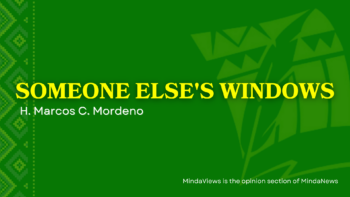CAGAYAN DE ORO CITY (MindaNews/14 Apr) – The location of the early morning “Pamalas” ritual to ward off evil spirits from the “yutang kabilin” was perfect. The even this morning was, after all, the kickoff of the five-day Earth Day activities by a lumad group.
Although organizers from the Kalumbay Regional Lumad Organization (Kalumbay) may have inadvertently chosen the location, the venue of the ceremonies was at the foot of the Huluga Cave, the site where the remains of a female and child dated to be about 2,000 years old was found by archeologists in 1977. Taguanao is believed to be the ancient Cagayan de Oro, then named Himologan and headed by Datu Salangsang in the 16th century.
And like the fortressed Himologan of old, lumads from the Higaonon, Manobo, Matigsalug, Banwaon, Talaandig, Tigwahanon, Umayamnon and B’laan tribes assembled to take stock of their present plight characterized by “development aggression” and reaffirm their fight for their land.
A B’laan leader who travelled all the way from Sarangani said that the lumads, like any other people, long for development, “but not the kind of development private companies and government impose on them.”
Mining, logging and plantation expansion are some of the economic activities the lumads brand as development aggression.
Dulphing Ogan, the B’laan secretary-general of the Kusog sa Katawhang Lumad sa Mindanao (Kalumaran), said that celebration of the Earth Day is very important to them because the lumad’s identity and culture is closest to mother nature.
This time though the Earth Day celebration is meant to dramatize the “lumad’s fight for their land. A fight for their identity and culture as a people. A fight centered on three issues, namely, yutang kabilin (ancestral land), yutang gibilin (land left over by development) and yutang ibilin (land that will be passed on to the next generation of lumads),” Ogan explained.
“What the lumads want is development that centers on making the land productive for agriculture and not the kind of development pushed by the government that aggressively displaces us from our ancestral domain,” said Jomorito “Datu Inbanwag” Goaynon, the Higaonon chairperson of Kalumbay.
“But more than yutang kabilin or yutang gibilin, what we are now after is yutang ibilin,” he said, even as he disclosed the fears of many lumads that the present generation will no longer have any land to pass on to the next lumad generations if the alleged state-sponsored development aggression in lumad ancestral lands will not be stopped.
Datu Mansagana narrated how their land in Agusan del Sur once produced bountiful harvest of rice. But when the logging company came and later left after harvesting the forests, they could no longer make rice grow from their land because “Magbabaya was angry at us for not protecting the forest.” This he was narrating in the Talaandig dialect, which was later translated to Cebuano by Datu Roger Planas, a Higaonon.
Datu Kasaluhan also narrated that before a logging company came to their land in Agusan del Sur, their rice barns were full and that harvests from previous seasons were not consumed.
“But after the coming of the logging firm, we were left without any produce that we could hardly buy even a single can of rice. When before we enjoyed the bounty of the land, now we are destitute. This is because Magababaya is angry,” he said.
Other datus (tribal chieftains) who attended the celebration – Datu Mandayhon Mansagana (Talaandig tribe of Agusan del Sur), Datu Kasaluhan (Manobo tribe of Agusan del Sur), Edgardo “Datu Tawin-Tawin” Mambukon (Tigwahanon tribe of San Fernando, Bukidnon), and Peligrino “Datu Mansuwagan” Bulalahaw (Higaonon of Naawan, Misamis Oriental) – narrated how this so-called development aggression resulted to violations of the lumads’ basic human rights as well as made their ancestral land fallow.
The Huluga Archeological Complex is composed of a cave site and an open site. It became controversial when Mayor Vicente Emano decided to construct a bridge that traversed the open site in 2000. The bridge which is now named after the illustrious son of Misamis Oriental and former Vice President Emmanuel Pelaez, according to the Heritage Conservation Advocates, substantially destroyed the open site.
Various artifacts have been collected in the open site, among them pottery shards, flakes of obsidian glass (used as cutting instrument before the iron age), fossilized bones, a midden (ancient kitchen), ancient farming and fishing implements, among others.
The cave site itself is now located within the landholding of the family of a former regional executive director of the Department of Environment and Natural Resources in Northern Mindanao.
On April 19, Kalumbay would be celebrating Earth Day “as a time when we should remember the provider of all our needs – Mother Nature as created by Manama Magbabaya. We, as a regional formation of different Lumad groups in the provinces of Misamis Oriental, Bukidnon, Agusan del Norte and Agusan del Sur, are hosting a gathering of tribal leaders from the communities our membership encompasses to perform a ritual committing to protect the environment,” according to the organization’s press statement. (BenCyrus G. Ellorin / MindaNews)
